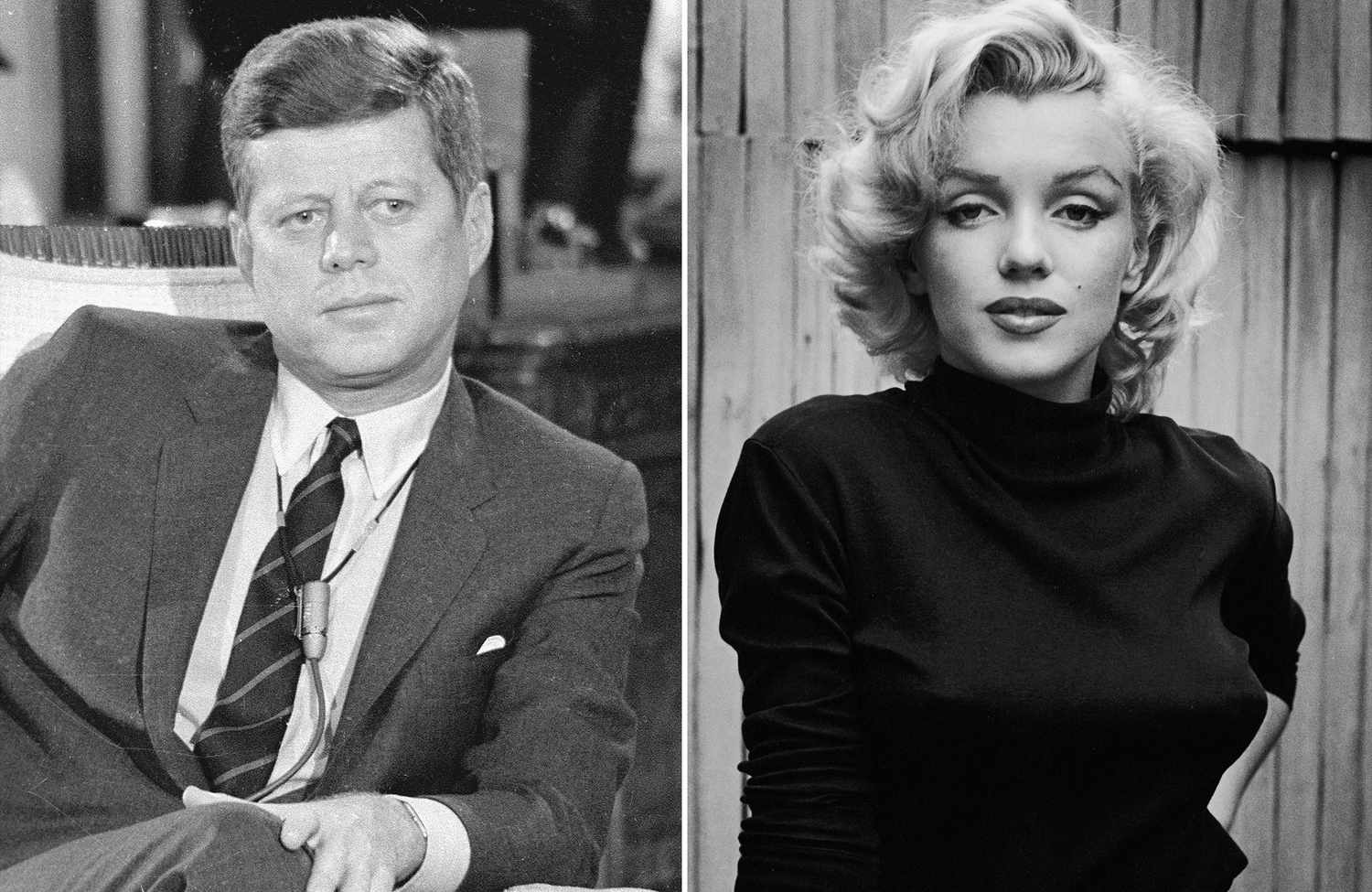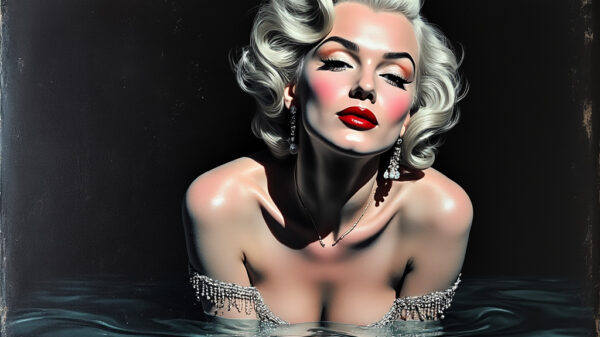1. The Initial Connection (1954-1955)
The story of Marilyn Monroe‘s connection to the Kennedy family began in 1954 when actor Peter Lawford, who had married into the Kennedy clan, first introduced the Hollywood star to then-Senator John F. Kennedy.
However, it wasn’t until 1955 that a more significant meeting occurred at a party hosted by Charles Feldman, the producer of Monroe’s blockbuster film “The Seven Year Itch.”
The party proved to be a pivotal moment, though Monroe attended without her husband at the time, Joe DiMaggio, who had explicitly opposed her presence at the gathering.
Kennedy was in town visiting his sister and brother-in-law, while his wife Jackie remained in Boston.
While this initial encounter was reportedly platonic, it set the stage for what would become one of the most infamous relationships in American political and entertainment history.
Peter Lawford’s role would prove crucial in the years to come.
His Santa Monica beach house would become what insiders referred to as Kennedy’s “de facto West Coast office, crash pad and Hollywood hospitality center.”
Lawford would later earn the nickname “Jack Kennedy’s sexual archivist” due to his role in facilitating and managing Kennedy’s Hollywood connections.
2. The Development of Relations (Late 1950s-Early 1960s)
As Kennedy’s political star rose, his connection to Hollywood’s biggest star deepened.
Lawford’s beach house became a central location for their encounters, with the property allegedly being used for numerous liaisons with Hollywood actresses.
According to private investigator Fred Otash’s recently revealed files, the house was under surveillance, and he claimed to have recordings of Kennedy having “sexual congress” with Monroe.
Interestingly, Monroe wasn’t the first Hollywood actress to be recorded with Kennedy at the beach house.
That distinction allegedly belonged to Jayne Mansfield, another blonde bombshell who was considered Monroe’s competition at 20th Century Fox.
However, Monroe would become, as Otash noted in his recordings, “the central figure… because she was the best known.”
The relationship between Monroe and Kennedy was complex and multifaceted.
Senator George Smathers, quoted in biographical accounts, revealed Kennedy’s perspective: “He thought she was beautiful, but maybe not the smartest girl in the world. He liked her sense of humor and her playfulness.”
Smathers noted that since the first lady was “more serious,” Kennedy enjoyed spending time with someone who was “just… not.”
3. The Palm Springs Weekend (March 1962)
The most documented encounter between Monroe and Kennedy occurred during the weekend of March 24, 1962, at Bing Crosby’s Palm Springs home.
This weekend would later be described by biographer J.
Randy Taraborrelli as the only confirmed sexual encounter between the two, though rumors of a longer affair persisted.
The timing was significant – Jackie Kennedy was traveling abroad with her sister Lee Radziwill and friend Joan Braden.
During this period, the president actually received a telegram from his wife while entertaining Monroe.
The weekend would later come to haunt Jackie Kennedy, as rumors began circulating about the encounter.
Lee Radziwill, who knew Monroe socially, later warned her sister about “a lot of chatter” concerning both John and Robert Kennedy’s involvement with the actress.
She also cautioned that Monroe “was addicted to certain medications and seeing a psychiatrist almost daily.”
Upon hearing these rumors, Jackie Kennedy confronted her husband, demanding an end to whatever relationship existed with Monroe.
While John maintained they were just friends, he agreed to distance himself.
4. The Fateful Phone Call (April 1962)
One of the most intriguing episodes in this saga occurred in April 1962, when Monroe made what would become a haunting phone call to the Kennedy’s private residence in Hyannis Port, Massachusetts.
Jackie Kennedy, who answered the call in her bedroom, was immediately struck by the familiar breathy voice on the other end.
The conversation, though brief, would leave a lasting impression.
According to Taraborrelli’s account, the exchange went as follows:
Monroe: “Is Jack home?”
Jackie: [After asking who was calling] “No, he isn’t.”
Monroe: “Marilyn Monroe.
Is this Jackie?”
Jackie: “Yes.”
Monroe: “Would you tell him I called?”
Jackie: “What is this regarding?”
Monroe: “Nothing in particular. I just wanted to say hello.”
What made this call particularly mysterious was that it came through on a private line that went directly to the Kennedy bedroom – a number known only to a select few family members and not monitored by the Secret Service.
Jackie Kennedy was so perplexed by how Monroe obtained the number that she even wondered if her half-brother Jamie Auchincloss, known for pranks, might have been imitating the actress.
However, Auchincloss, who was 14 at the time, later confirmed to Taraborrelli that he had never imitated Monroe.
Jackie later confided to her mother that while the call was “off-putting,” Monroe’s voice had a “sad” and “ethereal, little-girl-lost quality” that she found deeply “disturbing.”
This phone call would continue to haunt Jackie Kennedy for years to come, with family members noting that she spoke of it frequently, describing a “haunting quality to Marilyn’s voice that really stuck with her.”
5. The Birthday Celebration (May 19, 1962)
The most public intersection of Monroe and Kennedy’s worlds occurred on May 19, 1962, at Madison Square Garden, during President Kennedy’s 45th birthday celebration.
The event would produce one of the most iconic moments in American popular culture, with Monroe’s sultry rendition of “Happy Birthday, Mr. President.”
For the performance, Monroe wore a flesh-colored Jean Louis dress adorned with 1,200 rhinestone beads, creating the provocative illusion of nudity.
The performance was so suggestive that one gossip columnist remarked it “seemed like Marilyn was making love to the president in front of 40 million Americans.”
Notably absent from the celebration was Jackie Kennedy.
Despite pressure from various quarters, including her mother and the Secret Service, who worried that her absence would fuel rumors, Jackie refused to attend.
Agent Joseph Paolella had argued that if the first lady didn’t attend the bash, it would fuel rumors and “the lie becomes the truth.”
Instead of attending, Jackie Kennedy spent the evening at Glen Ora, the couple’s rented country estate outside Middleburg, Virginia, hosting a family cookout.
As Taraborrelli notes, “When Jackie learned that Marilyn was going to be singing ‘Happy Birthday’ to her husband, she put her foot down and said she was not going… If you think about this today, how scandalous it would have been?”
6. Final Months and Relationships (Summer 1962)
The summer of 1962 marked a tumultuous period in Monroe’s life, with increasing speculation about her relationships with both Kennedy brothers.
While her affair with President Kennedy had reportedly cooled, rumors circulated about a developing relationship with Attorney General Robert Kennedy.
However, biographer Taraborrelli found no concrete evidence to support the alleged affair with Robert Kennedy, noting that “Marilyn [would] exaggerate her relationships with people, especially with the Kennedys.”
He explained, “In Marilyn’s head, she had blown up her relationship with JFK to the point where it was a full-blown affair.
And she had sort of reasoned in her head that she had something going on with Bobby as well.”
During this period, there were reports that Monroe had threatened to hold a press conference to disclose her relationships with both Kennedy brothers.
The situation became increasingly volatile, with Monroe’s emotional state deteriorating and her dependence on medication growing more severe.
7. The Last Day (August 4, 1962)
The events of August 4, 1962, remain shrouded in controversy and competing accounts.
According to Fred Otash’s surveillance records, recently revealed in “The Fixer,” Robert Kennedy visited Monroe that morning around eleven o’clock.
During this visit, a heated argument allegedly occurred, with Monroe confronting Kennedy: “Where were you when I had to get an abortion of your kid, you no-good bastard?”
That evening, Monroe made a series of desperate phone calls.
Otash’s records indicate she called Lawford twice, JFK once, and then Lawford one final time.
In her last call to Lawford, she reportedly said, “Say goodbye to Pat. Say goodbye to the president and say goodbye to yourself because you’re a nice guy.”
According to the Netflix documentary “The Mystery of Marilyn Monroe: The Unheard Tapes,” Robert Kennedy and his family were officially in Northern California at the home of attorney John Bates.
However, several sources claim he visited Monroe in Los Angeles hours before her death to end their relationship, leading to an intense argument.
When Lawford arrived at Monroe’s home after her final call, he found her dead.
Instead of immediately calling authorities, Otash alleged that Lawford “started rummaging around, trying to pick all the s— he could that would implicate anyone.”
8. The Aftermath
The impact of Monroe’s death reverberated through the Kennedy family, particularly affecting Jackie Kennedy.
When she received the news at Hyannis Port from her social secretary Letitia Baldridge, Jackie was deeply troubled.
According to Taraborrelli, she felt Monroe was “a disaster waiting to happen” and had been “too vulnerable, too weak to be played with by JFK or by anybody else.”
Despite having a planned vacation to Italy with her sister, Jackie was “very bereft” by Monroe’s death and wanted to cancel the trip.
Her son John Jr. was also ill with the flu, adding to her reluctance.
While Lee Radziwill convinced her to go ahead with the vacation, witnesses reported that Jackie was “very much depressed during the entire time” and “wasn’t in a place where she felt like celebrating anything.”
Years later, in the 1970s, the story took another turn when Jackie Kennedy began sessions with psychoanalyst Dr. Marianne Kris.
During these sessions, which addressed her “ongoing PTSD” from her first husband’s assassination and issues in her marriage to Aristotle Onassis, Jackie made a shocking discovery: Kris had been Monroe’s psychiatrist.
When confronted about this connection, Kris asked, “How is this relevant?” to which Jackie replied, “How is that not relevant?” Jackie reportedly told Kris, “Everyone on the planet knows what I went through with Jack and Marilyn.”
Despite this revelation, Jackie continued her therapy with Kris, even discussing the haunting phone call from years before.
9. Revelations and Investigations
Over the decades following Monroe’s death, numerous investigations and revelations have emerged.
Joe DiMaggio, Monroe’s second husband, reportedly blamed the Kennedys for her death.
According to Dr. Rock Positano’s biography “Dinner with DiMaggio,” the baseball star stated, “The whole lot of Kennedys were lady-killers, and they always got away with it. They’ll be getting away with it a hundred years from now.”
DiMaggio further confided, “I always knew who killed her, but I didn’t want to start a revolution in this country.
She told me someone would do her in, but I kept quiet.”
He explained that Monroe’s involvement with “the Kennedy clan put her in a position where maybe it wasn’t good for her mental health or her emotional health.”
The 2022 Netflix documentary “The Mystery of Marilyn Monroe: The Unheard Tapes” presented previously unheard recordings of interviews with those close to the star, calling into question much of what was known about the night she died.
Anthony Summers, who conducted these interviews, concluded that while there was evidence of a cover-up related to Monroe’s death, it was likely due to her connections with the Kennedy brothers rather than murder.
10. Cultural Impact and Legacy
The story of Marilyn Monroe and the Kennedys has become deeply embedded in American cultural mythology, representing a unique intersection of politics, power, and celebrity.
The infamous “Happy Birthday” performance remains one of the most recognizable moments in popular culture, while the circumstances surrounding Monroe’s death continue to generate discussion and debate.
The only known photograph of either Kennedy with Monroe, taken at Arthur Krim’s home after the birthday performance, was kept secret by White House photographer Cecil Stoughton for decades before its release in 2010, underscoring the sensitive nature of their connection even years after the principal figures had passed away.
The saga has sparked countless books, documentaries, and investigations, with new revelations and theories continuing to emerge decades later.
As biographer James Spada noted, “What happened to Marilyn Monroe is one of the great mysteries of the 20th century.”
While he didn’t believe there was proof that the Kennedys were responsible for Monroe’s death, he maintained that “it was pretty clear that Marilyn had had sexual relations with both Bobby and Jack.”
The story continues to fascinate new generations, representing a pivotal moment where the worlds of Hollywood glamour and Washington power converged, with tragic consequences.
It remains a cautionary tale about the dangers of power, fame, and the complex intersection of public and private lives in American society.
Read more



